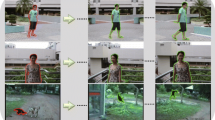Abstract
In this work, we propose an approach for on-line video multi object segmentation based on skeleton model and occlusion detection. We consider the multi-object segmentation in every frame as a multi-class region merging based object segmentation. We then generate the initial object superpixels automatically using a skeleton model from the second frame. Moreover, we also propose an initial background superpixel prediction scheme. In case the occlusion to affect the final segmentation result, we propose an occlusion detection model based on optical flow. The experimental results show that our method is both robust in segmenting multi objects and efficient in execution time.














Similar content being viewed by others
References
Achanta R, Hemami S, Estrada F, Susstrunk S (2009) Frequency-tuned salient region detection. In: Computer vision and pattern recognition. CVPR 2009. IEEE conference on, pp 1597–1604
Achanta R, Shaji A, Smith K, Lucchi A, Fua P, Süsstrunk S (2012) SLIC Superpixels compared to state-of-the-art superpixel methods. IEEE Trans Pattern Anal Mach Intell 34(11):2274–2282
Bai X, Wang J, Simons D, Sapiro G (2009) Video SnapCut: robust video object cutout using localized classifiers. ACM Trans Graph 28(3):1–11
Bouguet J-Y (2000) Pyramidal implementation of the Lucas Kanade feature tracker: description of the algorithm. Available: http://citeseerx.ist.psu.edu/viewdoc/summary?doi=10.1.1.185.585
Brendel W, Todorovic S (2009) Video object segmentation by tracking regions. In: 2009 IEEE 12th international conference on computer vision, pp 833–840
Comaniciu D, Meer P (2002) Mean shift: a robust approach toward feature space analysis. IEEE Trans Pattern Anal Mach Intell 24(5):603–619
Dey TK, Zhao W (2002) Approximating the medial axis from the voronoi diagram with a convergence guarantee. In: Möhring R, Raman R (eds) Algorithms — ESA 2002: 10th annual European symposium Rome, Italy, September 17–21, 2002 proceedings. Springer, Berlin, pp 387–398
Endres I, Hoiem D (2010) Category independent object proposals. In: Part V, Daniilidis K, Maragos P, Paragios N (eds) Computer vision – ECCV 2010: 11th European conference on computer vision, Heraklion, Crete, Greece, September 5–11, 2010, proceedings. Springer, Berlin, pp 575–588
Grundmann M, Kwatra V, Han M, Essa I (2010) Efficient hierarchical graph-based video segmentation. In: 2010 IEEE conference on computer vision and pattern recognition (CVPR), pp 2141–2148
Horn BKP, Schunck BG (1980) Determining optical flow. Massachusetts Institute of Technology, Cambridge
Jian M, Lam K-M, Dong J (2014) Facial-feature detection and localization based on a hierarchical scheme. Inf Sci 262:1–14
Jian M, Lam KM, Dong J, Shen L (2015) Visual-patch-attention-aware saliency detection. IEEE Trans Cybern 45(8):1575–1586
Jian M, Qi Q, Dong J, Sun X, Sun Y, Lam K-M (2017) Saliency detection using quaternionic distance based weber local descriptor and level priors. Multimed Tools Appl 1–18. https://doi.org/10.1007/s11042-017-5032-z
Jian M, Qi Q, Dong J, Yin Y, Lam KM (2018) Integrating QDWD with pattern distinctness and local contrast for underwater saliency detection. J Vis Commun Image Represent 53:31–41
Jian MW, Dong JY, Ma J (2011) Image retrieval using wavelet-based salient regions. Imaging Sci J 59(4):219–231
Lee YJ, Kim J, Grauman K (2011) Key-segments for video object segmentation. In: 2011 International conference on computer vision, pp 1995–2002
Levinshtein A, Stere A, Kutulakos KN, Fleet DJ, Dickinson SJ, Siddiqi K (2009) TurboPixels: fast Superpixels using geometric flows. IEEE Trans Pattern Anal Mach Intell 31(12):2290–2297
Li F, Kim T, Humayun A, Tsai D, Rehg JM (2013) Video segmentation by tracking many figure-ground segments. In: 2013 IEEE international conference on computer vision, pp 2192–2199
Ning J, Zhang L, Zhang D, Wu C (2010) Interactive image segmentation by maximal similarity based region merging. Pattern Recogn 43(2):445–456
Ochs P, Malik J, Brox T (2014) Segmentation of moving objects by long term video analysis. IEEE Trans Pattern Anal Mach Intell 36(6):1187–1200
Papazoglou A, Ferrari V (2013) Fast object segmentation in unconstrained video. In: 2013 IEEE international conference on computer vision, pp 1777–1784
Taylor B, Karasev V, Soattoc S (2015) Causal video object segmentation from persistence of occlusions. In: 2015 IEEE conference on computer vision and pattern recognition (CVPR), pp 4268–4276
Varas D, Marques F (2014) Region-based particle filter for video object segmentation. In: 2014 IEEE conference on computer vision and pattern recognition, pp 3470–3477
Wenguan W, Jianbing S, Porikli F (2015) Saliency-aware geodesic video object segmentation. In: 2015 IEEE conference on computer vision and pattern recognition (CVPR), pp 3395–3402
Willert V, Eggert J, Clever S, Körner E (2005) Probabilistic color optical flow. In: Kropatsch WG, Sablatnig R, Hanbury A (eds) Pattern recognition: 27th DAGM symposium, Vienna, Austria, august 31–September 2, 2005. Proceedings. Springer, Berlin, pp 9–16
Zhang X, Shan Y, Wei W, Zhu Z (2010) An image segmentation method based on improved watershed algorithm. In: Computational and information sciences (ICCIS), 2010 international conference on, pp 258–261
Zhang D, Javed O, Shah M (2013) Video object segmentation through spatially accurate and temporally dense extraction of primary object regions. In: 2013 IEEE conference on computer vision and pattern recognition (CVPR), pp 628–635
Acknowledgements
This work was supported in part by the Research Committee of the University of Macau under Grants MYRG2015-00011-FST and MYRG2015-00012-FST, the Science and Technology Development Fund of Macau SAR under Grants 093/2014/A2 and 041/2017/A1, and the project (2018 - 2020, Video Multi-object Co-segmentation Based on Superpixel, National Natural Science Foundation of China (NSFC) Grant No. 61702111).
Author information
Authors and Affiliations
Corresponding author
Rights and permissions
About this article
Cite this article
Huang, G., Pun, CM. On-line video multi-object segmentation based on skeleton model and occlusion detection. Multimed Tools Appl 77, 31313–31329 (2018). https://doi.org/10.1007/s11042-018-6208-x
Received:
Revised:
Accepted:
Published:
Issue Date:
DOI: https://doi.org/10.1007/s11042-018-6208-x




